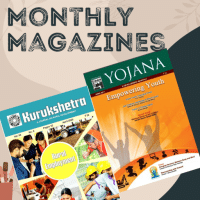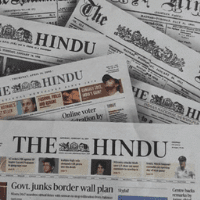Current Affairs Exam > Current Affairs Questions > Consider the following statements:1. P-8I pat...
Start Learning for Free
Consider the following statements:
1. P-8I patrol aircraft is a long-range maritime reconnaissance and anti-submarine warfare aircraft.
2. The US has granted India the same access to defence technology as it grants to its NATO allies.
Which of the statements given above is/are correct?
- a)1 only
- b)2 only
- c)Both 1 and 2
- d)Neither 1 nor 2
Correct answer is option 'C'. Can you explain this answer?
Most Upvoted Answer
Consider the following statements:1. P-8I patrol aircraft is a long-ra...
- P-8I patrol aircraft is a long-range maritime reconnaissance and anti-submarine warfare aircraft. Hence, statement 1 is correct.
- It is a variant of the P-8A Poseidon aircraft that Boeing company developed as a replacement for the US Navy’s ageing P-3 fleet.
- With a maximum speed of 907 kmph and an operating range of over 1,200 nautical miles, the P-8Is detect threats and neutralize them if required, far before they come anywhere near Indian shores.
- Indian Navy became the first international customer for the P-8 aircraft in 2009.
- Defense purchases from the United States have been increasingly an integral part of growing ties between the two countries.
- From near zero in 2008, India-US defence trade touched USD 20 billion in 2020, helped along by major policy upgrades.
- The US designating India a Major Defence Partner (in 2016) and then granting it the same access to defence technology as NATO allies and Australia, Japan and South Korea under Strategic Trade Authorization-1 (STA) in 2018. Hence, statement 2 is correct.
Free Test
FREE
| Start Free Test |
Community Answer
Consider the following statements:1. P-8I patrol aircraft is a long-ra...
P-8I Patrol Aircraft:
- The P-8I patrol aircraft is indeed a long-range maritime reconnaissance and anti-submarine warfare aircraft. It is a variant of the P-8A Poseidon aircraft developed by Boeing for the United States Navy.
- The P-8I is specifically designed to meet the requirements of the Indian Navy and is based on the Boeing 737 commercial aircraft. It is capable of operating in both littoral and open ocean environments.
- The aircraft is equipped with advanced sensors and systems that enable it to detect and track submarines, surface vessels, and other targets of interest. It can also conduct search and rescue missions, maritime surveillance, and anti-piracy operations.
- The P-8I patrol aircraft has been in service with the Indian Navy since 2013 and has significantly enhanced its maritime surveillance and anti-submarine warfare capabilities.
US Access to Defence Technology:
- The second statement is also correct. The United States has granted India the same access to defence technology as it grants to its NATO allies.
- This was announced during the visit of the then US Defense Secretary Ashton Carter to India in 2016. The US recognized India as a major defence partner and agreed to facilitate the transfer of advanced defence technologies and systems.
- This move aimed to strengthen the strategic partnership between the two countries and enhance India's defence capabilities. It opened up opportunities for collaboration in areas such as joint production, co-development, and technology sharing.
- The US-India Defence Technology and Trade Initiative (DTTI) was established to promote defence cooperation and facilitate the transfer of advanced technology. Under this initiative, several key projects have been identified in areas such as aircraft carrier design and construction, jet engine technology, and advanced avionics.
- The US has also designated India as a Strategic Trade Authorization-1 (STA-1) country, which allows for the export of more sensitive dual-use technologies with a greater ease.
- This access to advanced defence technology from the US has been instrumental in enhancing India's defence capabilities and fostering closer defense ties between the two countries.
Therefore, both statements 1 and 2 are correct. The P-8I patrol aircraft is indeed a long-range maritime reconnaissance and anti-submarine warfare aircraft, and the US has granted India the same access to defense technology as it grants to its NATO allies.
- The P-8I patrol aircraft is indeed a long-range maritime reconnaissance and anti-submarine warfare aircraft. It is a variant of the P-8A Poseidon aircraft developed by Boeing for the United States Navy.
- The P-8I is specifically designed to meet the requirements of the Indian Navy and is based on the Boeing 737 commercial aircraft. It is capable of operating in both littoral and open ocean environments.
- The aircraft is equipped with advanced sensors and systems that enable it to detect and track submarines, surface vessels, and other targets of interest. It can also conduct search and rescue missions, maritime surveillance, and anti-piracy operations.
- The P-8I patrol aircraft has been in service with the Indian Navy since 2013 and has significantly enhanced its maritime surveillance and anti-submarine warfare capabilities.
US Access to Defence Technology:
- The second statement is also correct. The United States has granted India the same access to defence technology as it grants to its NATO allies.
- This was announced during the visit of the then US Defense Secretary Ashton Carter to India in 2016. The US recognized India as a major defence partner and agreed to facilitate the transfer of advanced defence technologies and systems.
- This move aimed to strengthen the strategic partnership between the two countries and enhance India's defence capabilities. It opened up opportunities for collaboration in areas such as joint production, co-development, and technology sharing.
- The US-India Defence Technology and Trade Initiative (DTTI) was established to promote defence cooperation and facilitate the transfer of advanced technology. Under this initiative, several key projects have been identified in areas such as aircraft carrier design and construction, jet engine technology, and advanced avionics.
- The US has also designated India as a Strategic Trade Authorization-1 (STA-1) country, which allows for the export of more sensitive dual-use technologies with a greater ease.
- This access to advanced defence technology from the US has been instrumental in enhancing India's defence capabilities and fostering closer defense ties between the two countries.
Therefore, both statements 1 and 2 are correct. The P-8I patrol aircraft is indeed a long-range maritime reconnaissance and anti-submarine warfare aircraft, and the US has granted India the same access to defense technology as it grants to its NATO allies.

|
Explore Courses for Current Affairs exam
|

|
Similar Current Affairs Doubts
Consider the following statements:1. P-8I patrol aircraft is a long-range maritime reconnaissance and anti-submarine warfare aircraft.2. The US has granted India the same access to defence technology as it grants to its NATO allies.Which of the statements given above is/are correct?a)1 onlyb)2 onlyc)Both 1 and 2d)Neither 1 nor 2Correct answer is option 'C'. Can you explain this answer?
Question Description
Consider the following statements:1. P-8I patrol aircraft is a long-range maritime reconnaissance and anti-submarine warfare aircraft.2. The US has granted India the same access to defence technology as it grants to its NATO allies.Which of the statements given above is/are correct?a)1 onlyb)2 onlyc)Both 1 and 2d)Neither 1 nor 2Correct answer is option 'C'. Can you explain this answer? for Current Affairs 2025 is part of Current Affairs preparation. The Question and answers have been prepared according to the Current Affairs exam syllabus. Information about Consider the following statements:1. P-8I patrol aircraft is a long-range maritime reconnaissance and anti-submarine warfare aircraft.2. The US has granted India the same access to defence technology as it grants to its NATO allies.Which of the statements given above is/are correct?a)1 onlyb)2 onlyc)Both 1 and 2d)Neither 1 nor 2Correct answer is option 'C'. Can you explain this answer? covers all topics & solutions for Current Affairs 2025 Exam. Find important definitions, questions, meanings, examples, exercises and tests below for Consider the following statements:1. P-8I patrol aircraft is a long-range maritime reconnaissance and anti-submarine warfare aircraft.2. The US has granted India the same access to defence technology as it grants to its NATO allies.Which of the statements given above is/are correct?a)1 onlyb)2 onlyc)Both 1 and 2d)Neither 1 nor 2Correct answer is option 'C'. Can you explain this answer?.
Consider the following statements:1. P-8I patrol aircraft is a long-range maritime reconnaissance and anti-submarine warfare aircraft.2. The US has granted India the same access to defence technology as it grants to its NATO allies.Which of the statements given above is/are correct?a)1 onlyb)2 onlyc)Both 1 and 2d)Neither 1 nor 2Correct answer is option 'C'. Can you explain this answer? for Current Affairs 2025 is part of Current Affairs preparation. The Question and answers have been prepared according to the Current Affairs exam syllabus. Information about Consider the following statements:1. P-8I patrol aircraft is a long-range maritime reconnaissance and anti-submarine warfare aircraft.2. The US has granted India the same access to defence technology as it grants to its NATO allies.Which of the statements given above is/are correct?a)1 onlyb)2 onlyc)Both 1 and 2d)Neither 1 nor 2Correct answer is option 'C'. Can you explain this answer? covers all topics & solutions for Current Affairs 2025 Exam. Find important definitions, questions, meanings, examples, exercises and tests below for Consider the following statements:1. P-8I patrol aircraft is a long-range maritime reconnaissance and anti-submarine warfare aircraft.2. The US has granted India the same access to defence technology as it grants to its NATO allies.Which of the statements given above is/are correct?a)1 onlyb)2 onlyc)Both 1 and 2d)Neither 1 nor 2Correct answer is option 'C'. Can you explain this answer?.
Solutions for Consider the following statements:1. P-8I patrol aircraft is a long-range maritime reconnaissance and anti-submarine warfare aircraft.2. The US has granted India the same access to defence technology as it grants to its NATO allies.Which of the statements given above is/are correct?a)1 onlyb)2 onlyc)Both 1 and 2d)Neither 1 nor 2Correct answer is option 'C'. Can you explain this answer? in English & in Hindi are available as part of our courses for Current Affairs.
Download more important topics, notes, lectures and mock test series for Current Affairs Exam by signing up for free.
Here you can find the meaning of Consider the following statements:1. P-8I patrol aircraft is a long-range maritime reconnaissance and anti-submarine warfare aircraft.2. The US has granted India the same access to defence technology as it grants to its NATO allies.Which of the statements given above is/are correct?a)1 onlyb)2 onlyc)Both 1 and 2d)Neither 1 nor 2Correct answer is option 'C'. Can you explain this answer? defined & explained in the simplest way possible. Besides giving the explanation of
Consider the following statements:1. P-8I patrol aircraft is a long-range maritime reconnaissance and anti-submarine warfare aircraft.2. The US has granted India the same access to defence technology as it grants to its NATO allies.Which of the statements given above is/are correct?a)1 onlyb)2 onlyc)Both 1 and 2d)Neither 1 nor 2Correct answer is option 'C'. Can you explain this answer?, a detailed solution for Consider the following statements:1. P-8I patrol aircraft is a long-range maritime reconnaissance and anti-submarine warfare aircraft.2. The US has granted India the same access to defence technology as it grants to its NATO allies.Which of the statements given above is/are correct?a)1 onlyb)2 onlyc)Both 1 and 2d)Neither 1 nor 2Correct answer is option 'C'. Can you explain this answer? has been provided alongside types of Consider the following statements:1. P-8I patrol aircraft is a long-range maritime reconnaissance and anti-submarine warfare aircraft.2. The US has granted India the same access to defence technology as it grants to its NATO allies.Which of the statements given above is/are correct?a)1 onlyb)2 onlyc)Both 1 and 2d)Neither 1 nor 2Correct answer is option 'C'. Can you explain this answer? theory, EduRev gives you an
ample number of questions to practice Consider the following statements:1. P-8I patrol aircraft is a long-range maritime reconnaissance and anti-submarine warfare aircraft.2. The US has granted India the same access to defence technology as it grants to its NATO allies.Which of the statements given above is/are correct?a)1 onlyb)2 onlyc)Both 1 and 2d)Neither 1 nor 2Correct answer is option 'C'. Can you explain this answer? tests, examples and also practice Current Affairs tests.

|
Explore Courses for Current Affairs exam
|

|
Signup for Free!
Signup to see your scores go up within 7 days! Learn & Practice with 1000+ FREE Notes, Videos & Tests.


























